Ecological dynamics
The information in this Ecological Site Description, including the state-and-transition model (STM), was developed based on historical data, current field data, professional experience, and a review of the scientific literature. As a result, all possible scenarios or plant species may not be included. Key indicator plant species, disturbances, and ecological processes are described to inform land management decisions.
The MLRA lies within the transition zone between the eastern deciduous forests and the tallgrass prairies. The heterogeneous topography of the area results in variable microclimates and fuel matrices that in turn are able to support prairies, savannas, woodlands, and forests. Till Backslope Seepage Meadows form an aspect of this vegetative continuum. This ecological site occurs on upland hillslopes on somewhat poorly to poorly-drained soils. A shallow perched water table results in saturated soil conditions throughout most of the year. Species characteristic of this ecological site consist of hydrophytic herbaceous vegetation.
Till Backslope Seepage Meadows are dependent on consistent groundwater discharge. These conditions are present where surface slopes intersect a perched water table, allowing the groundwater to slowly seep from the hillside (Richardson and Brinson 2001; Dixon 2014). While water levels may fluctuate throughout the year, they generally remain at or near the soil surface (LANDFIRE 2009). The near-constant anaerobic conditions maintain the herbaceous wetland plant community and prevent woody species from encroaching.
Drought and fire have also played a role in shaping this ecological site. The periodic episodes of reduced soil moisture in conjunction with the somewhat poorly to poorly-drained soils have favored the proliferation of plant species tolerant of such conditions. Drought can also slow the growth of plants and result in dieback of certain species. Occasional fires reduced plant litter and aided in preventing declines in species richness. Drought coupled with fire would keep woody plants from encroaching (LANDFIRE 2009).
Today, Till Backslope Seepage Meadows have been greatly reduced as sites have been converted to agricultural production lands or converted to ponds. Sites that have not been directly altered show evidence of indirect anthropogenic influences from hydrologic alterations, fire suppression, and non-native species invasion (Pearson and Leoschke 1992). These land conversions and alterations to the natural groundwater flow are considered to be irreversible, making restoration an improbability. The state-and-transition model that follows provides a detailed description of each state, community phase, pathway, and transition. This model is based on available experimental research, field observations, literature reviews, professional consensus, and interpretations.
State 1
Reference State
The reference plant community is categorized as a groundwater-fed slope wetland community, dominated by hydrophytic herbaceous vegetation. The one community phase within the reference state is dependent on consistent groundwater seepage to maintain the plant community. Drought and occasional fires have more localized impacts in the reference state, but do contribute to overall species composition, diversity, cover, and productivity.
Community 1.1
Green Bulrush – Fox Sedge
Sites in this reference community phase are dominated by hydrophytic herbaceous vegetation. Green bulrush and fox sedge are dominant monocots on the site, but other frequently encountered species include woolly sedge (Carex pellita Muhl. ex Willd.), bluejoint (Calamagrostis canadensis (Michx.) P. Beauv.), spikerushes, and rushes. Forb species richness is often very high in these unique communities and typically includes many species with high conservative values, e.g., white turtlehead, stiff cowbane (Oxylpolis rigidior (L.) Raf.), Riddell’s goldenrod (Oligoneuron riddellii (Frank ex Riddell) Rydb.), and closed bottle gentian (Gentiana andrewsii Griseb.) (Pearson and Leoschke 1992).
State 2
Degraded Woody-invaded State
The expansion of ruderal woody and herbaceous species into Till Backslope Seepage Meadows can arise due to a complex interaction of fire suppression, hydrological alterations, and edge effects. Subsurface water reduction from agricultural tiling, ditching, or off-site development in conjunction with the removal of periodic fires allows woody species to encroach, casting shade on the native plant community and altering the natural light regime. In addition, edge effects can arise from indirect land management practices (e.g., cropping, herbicide drift) on directly adjacent sites that lead to a transition in the herbaceous species composition to taller, ruderal species (Pearson and Leoschke 1992; NatureServe 2015).
Community 2.1
Slippery Elm – Silky Dogwood/Great Ragweed – Stinging Nettle
This community phase represents the initial changes to the natural community following hydroperiod alterations and adjacent land management actions. Reduction in the water table allows woody species, such as slippery elm (Ulmus rubra Muhl.), silky dogwood (Cornus obliqua Raf.), and pussy willow (Salix discolor Muhl.), to establish a significant shrub cover. The herbaceous layer shifts to disturbance-tolerant, opportunistic species including great ragweed (Ambrosia trifida L.), stinging nettle (Urtica dioica L.), Canada lettuce (Lactuca canadensis L.), common milkweed (Asclepias syriaca L.), and common evening primrose (Oenothera biennis L.). Non-native invasive species, including reed canarygrass (Phalaris arundinacea L.), redtop (Agrostis gigantea Roth), and Kentucky bluegrass (Poa pratensis L.), begin to encroach as well (Pearson and Leoschke 1992).
Community 2.2
Slippery Elm/Silky Dogwood – Pussy Willow/Great Ragweed
Stinging Nettle – Sites falling into this community phase represent the natural succession as a result of continuing changes to the hydroperiod and adjacent lands. Slippery elm can mature into a tree canopy, and silky dogwood and pussy willow continue to form the dominant shrubs. The herbaceous layer continues to be simplified and inhabited by ruderal and non-native species.
Pathway 2.1A
Community 2.1 to 2.2
Natural succession as a result of continuing landscape changes.
Pathway 2.2A
Community 2.2 to 2.1
Limited woody species removal.
State 3
Forage State
The forage state arises when the site is converted to a farming system that emphasizes domestic livestock production, known as grassland agriculture. Tree removal, fire suppression, periodic cultural treatments (e.g., clipping, drainage, soil amendment applications, planting new species and/or cultivars, mechanical harvesting) and grazing by domesticated livestock transition and maintain this state (USDA-NRCS 2003). Early settlers seeded non-native species, such as smooth brome (Bromus inermis Leyss.) and Kentucky bluegrass (Poa pratensis L.), to help extend the grazing season (Smith 1998). Over time, as lands were continuously harvested or grazed by herds of cattle, these species were able to spread and expand across the landscape, reducing the native species diversity and ecological function.
Community 3.1
Hayfield
Sites in this community phase consist of forage plants that are planted and mechanically harvested. Mechanical harvesting removes much of the aboveground biomass and nutrients that feed the soil microorganisms (Franzluebbers et al. 2000; USDA-NRCS 2003). As a result, soil biology is reduced leading to decreases in nutrient uptake by plants, soil organic matter, and soil aggregation. Frequent biomass removal can also reduce the site’s carbon sequestration capacity (Skinner 2008). This phase may not be prevalent on this ecological site due to the high soil moisture making it difficult to run large equipment across it.
Community 3.2
Continuous Pastured Grazing
This community phase is characterized by continuous grazing where domestic livestock graze a pasture for the entire season. Depending on stocking density, this can result in lower forage quality and productivity, weed invasions, and uneven pasture use. Continuous grazing can also increase the amount of bare ground and erosion and reduce soil organic matter, cation exchange capacity, water-holding capacity, and nutrient availability and retention (Bharati et al. 2002; Leake et al. 2004; Teague et al. 2011). Smooth brome, Kentucky bluegrass, and white clover (Trifolium repens L.) are common pasture species used in this phase. Their tolerance to continuous grazing has allowed these species to dominate, greatly reducing the native species diversity to only low palatability, disturbance-tolerant species.
Community 3.3
Periodic-rest Pastured Grazing
This community phase is characterized by periodic-rest grazing where the pasture has been subdivided into several smaller paddocks. Subdividing the pasture in this way allows livestock to utilize one or a few paddocks, while the remaining area is rested allowing plants to restore vigor and energy reserves, deepen root systems, develop seeds, as well as allow seedling establishment (Undersander et al. 2002; USDA-NRCS 2003). Periodic-rest pastured grazing includes deferred periods, rest periods, and periods of high intensity – low frequency, and short duration methods. Vegetation is generally more diverse and can include orchardgrass (Dactylis glomerata L.), timothy (Phleum pretense L.), red clover (Trifolium pratense L.), and alfalfa (Medicago sativa L.). The addition of native prairie species can further bolster plant diversity and, in turn, soil function. This community phase promotes numerous ecosystem benefits including increasing biodiversity, preventing soil erosion, maintaining and enhancing soil quality, sequestering atmospheric carbon, and improving water yield and quality (USDA-NRCS 2003).
Pathway 3.1A
Community 3.1 to 3.2
Mechanical harvesting is replaced with domestic livestock utilizing continuous grazing.
Pathway 3.1B
Community 3.1 to 3.3
Mechanical harvesting is replaced with domestic livestock utilizing periodic-rest grazing.
Pathway 3.2A
Community 3.2 to 3.1
Domestic livestock are removed, and mechanical harvesting is implemented.
Pathway 3.2B
Community 3.2 to 3.3
Periodic-rest grazing replaces continuous grazing.
Pathway 3.3B
Community 3.3 to 3.1
Domestic livestock are removed, and mechanical harvesting is implemented.
Pathway 3.3A
Community 3.3 to 3.2
Continuous grazing replaces periodic-rest grazing.
State 4
Cropland State
The cropland state is the dominant land condition throughout the MLRA today. Agricultural tile drains used to lower the water table and the continuous use of tillage, row-crop planting, and chemicals (i.e., herbicides, fertilizers, etc.) have effectively eliminated the reference community and many of its natural ecological functions in favor of crop production. Corn and soybeans are the dominant crops for the site, and oats (Avena L.) and alfalfa (Medicago sativa L.) may be rotated periodically. These areas are likely to remain in crop production for the foreseeable future.
Community 4.1
Conventional Tillage Field
Sites in this community phase typically consist of monoculture row-cropping maintained by conventional tillage practices. They are cropped in either continuous corn or corn-soybean rotations. The frequent use of deep tillage, low crop diversity, and bare soil conditions during the non-growing season negatively impacts soil health. Under these practices, soil aggregation is reduced or destroyed, soil organic matter is reduced, erosion and runoff are increased, and infiltration is decreased, which can ultimately lead to undesirable changes in the hydrology of the watershed (Tomer et al. 2005).
Community 4.2
Conservation Tillage Field
This community phase is characterized by periodically alternating crops and utilizing various conservation tillage methods to promote soil health and reduce erosion. Conservation tillage methods include strip-till, ridge-till, vertical-till, or no-till planting operations. Strip-till keeps seedbed preparation to narrow bands less than one-third the width of the row where crop residue and soil consolidation are left undisturbed in-between seedbed areas. Strip-till planting may be completed in the fall and nutrient application either occurs simultaneously or at the time of planting. Ridge-till uses specialized equipment to create ridges in the seedbed and vegetative residue is left on the surface in between the ridges. Weeds are controlled with herbicides and/or cultivation, seedbed ridges are rebuilt during cultivation, and soils are left undisturbed from harvest to planting. Vertical-till operations employ machinery that lightly tills the soil and cuts up crop residue, mixing some of the residue into the top few inches of the soil while leaving a large portion on the surface. No-till management is the most conservative, disturbing soils only at the time of planting and fertilizer application. Compared to conventional tillage operations, conservation tillage methods can improve soil ecosystem function by reducing soil erosion, increasing organic matter and water availability, improving water quality, and reducing soil compaction.
Community 4.3
Conservation Tillage with Cover Crop Field
This community phase applies conservation tillage methods as described above as well as adds cover crop practices. Cover crops typically include nitrogen-fixing species (e.g., legumes), small grains (e.g., rye, wheat, oats), or forage covers (e.g., turnips, radishes, rapeseed). The addition of cover crops not only adds plant diversity but also promotes soil health by reducing soil erosion, limiting nitrogen leaching, suppressing weeds, increasing soil organic matter, and improving the overall soil ecosystem. In the case of small grain cover crops, surface cover and water infiltration are increased, while forage covers can be used to graze livestock or support local wildlife. Of the three community phases for this state, this phase promotes the greatest soil sustainability and improves ecological functioning within a row crop operation.
Pathway 4.1A
Community 4.1 to 4.2
Tillage operations are greatly reduced, crop rotation occurs on a regular interval, and crop residue remains on the soil surface.
Pathway 4.1B
Community 4.1 to 4.3
Tillage operations are greatly reduced or eliminated, alternating crops occurs on a regular interval, crop residue remains on the soil surface, and cover crops are planted following crop harvest.
Pathway 4.2A
Community 4.2 to 4.1
Intensive tillage is utilized, and monoculture row-cropping is established.
Pathway 4.2B
Community 4.2 to 4.3
Cover crops are implemented to minimize soil erosion.
Pathway 4.3B
Community 4.3 to 4.1
Intensive tillage is utilized, cover crops practices are abandoned, monoculture row-cropping is established, and crop rotation is reduced or eliminated.
Pathway 4.3A
Community 4.3 to 4.2
Cover crop practices are abandoned.
State 5
Pond State
Ponds may be regularly encountered throughout the MLRA, having been impounded or excavated for a variety of reasons including watering livestock, creating waterfowl habitat, and establishing fisheries (Pearson and Leoschke 1992). Through excavation, the native vegetation is removed, and groundwater seepage can rapidly fill the exposed area and transition the diverse seepage meadow into an open water habitat. Over time, sediments may accumulate along the edges of the pond where emergent vegetation, introduced by wind or wildlife, can germinate and establish.
Community 5.1
Cattail – open water
This community phase is characterized mostly by open water. Along the shallow edges of the water, a limited diversity of emergent vegetation may establish. Cattails (Typha L.) and bulrushes (Scirpus L., Bolboschoenus (Asch.) Palla) are the most commonly encountered species. Other emergent and aquatic species reported from the MLRA include American water plantain (Alisma subcordatum Raf.)), pondweed (Potamogeton L.), and winged loosestrife (Lythrum alatum Pursh) (Runkel and Roosa 2014).
Transition T1A
State 1 to 2
Changes to the natural hydroperiod and edge effects from adjacent land uses transition this site the degraded woody-invaded state (2).
Transition T1B
State 1 to 3
Cultural treatments to enhance forage quality and yield transition the site to the forage state (3).
Transition T1C
State 1 to 4
Installation of drain tiles, seeding of agricultural crops, and non-selective herbicide transition the site to the cropland state (4).
Transition T1D
State 1 to 5
Removal of natural vegetation and excavation transition the site to the pond state (5).
Transition T2A
State 2 to 3
Cultural treatments to enhance forage quality and yield transition the site to the forage state (3).
Transition T2B
State 2 to 4
Installation of drain tiles, seeding of agricultural crops, and non-selective herbicide transition the site to the cropland state (4).
Transition T3A
State 3 to 2
Land is abandoned and left fallow; natural succession by opportunistic and non-native species transition this site the disturbed state (2).
Transition T3B
State 3 to 4
Installation of drain tiles, tillage, seeding of agricultural crops, and non-selective herbicide transition the site to the cropland state (4).
Transition T3C
State 3 to 5
Removal of natural vegetation and excavation transition the site to the pond state (5).
Transition T4A
State 4 to 2
Agricultural production abandoned and left fallow; natural succession by opportunistic and non-native species transition this site to the degraded state (2).
Transition T4B
State 4 to 3
Cultural treatments to enhance forage quality and yield transition the site to the forage state (3).





